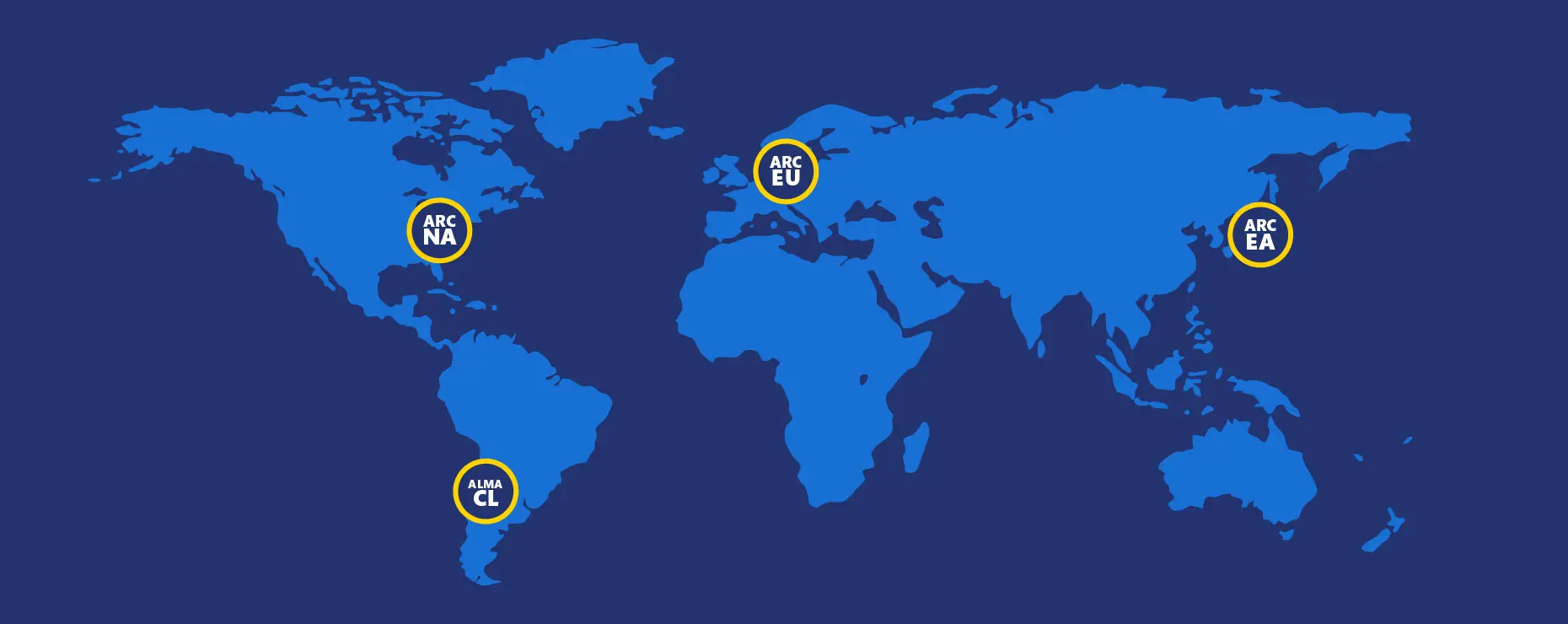How ALMA Observations are carried out
Who can apply for ALMA time?
Scientists from all over the world use ALMA!
ALMA will operate for many decades, and it will be used by several generations, including those who are currently elementary and junior high school students.
10% of observation time is allocated to the host country, Chile, and 90% for the partners, according to their financial contribution to ALMA. All partners contribute observing time toward “Open Skies” so that any astronomer can apply for ALMA time regardless of affiliation.
Another important aspect is that ALMA is designed to give calibrated data products to its users. Therefore, even non-expert researchers can use ALMA!
How does ALMA decide which projects to observe?
Once a year, ALMA splits a Call for Proposals where scientists can apply to use ALMA by submitting an observing proposal, which describes the observations they wish to carry out, what they hope to learn from the ALMA data, and how much time on ALMA is needed. These proposals are peer-reviewed by other astronomers, who collectively determine which proposals are most scientifically exciting and should have priority to observe. To make the process as fair as possible, the proposing team's and the reviewers' identities are not disclosed. Time on ALMA is in high demand, so typically, only one proposal out of five can be observed.
Since the Call for Proposals for Cycle 8, a distributed evaluation system among peers was implemented. Each team of astronomers that requests observation time with ALMA must evaluate about twenty proposals from their peers. At least ten evaluators thus review each proposal before it is assigned a ranking and its priority for observation is determined.
Occasionally, an urgent, high-priority observation may be needed that must be completed on the next regular Call for Proposals. In these cases, astronomers can submit a proposal to the ALMA Director requesting observing time on ALMA, who will decide whether the proposal should be scheduled.
Researchers from the selected projects do not travel to Chajnantor to carry out the observations, but this task is carried out by ALMA astronomers working at the Operations Support Facility. The ALMA astronomers will select which proposals to observe based on the priority from the review process, weather conditions, and the antenna array configuration. Science observations are carried out day and night, except when time is needed for hardware and software maintenance, for testing new capabilities, and when the weather conditions are adverse.
The observation data are then calibrated and transmitted via fiber optics to the ALMA Regional Centers (ARCs), who, in turn, deliver them to the project’s Principal Investigator.
How are the observations obtained?
The Joint ALMA Observatory (JAO) issues calls for scientists worldwide to submit their proposals for observation time through the ARCs. The JAO, with assistance from the ARCs, coordinates the refereeing process. The cycles of observation carried out by ALMA are as follows:
Cycle 0 (Preliminary observations with 16 antennae): September 2011 to January 2013
Cycle 1 (Early Science with 43 antennas): Early 2013.
Cycle 2 (Early Science with 45 antennas): As of June 2014.
Cycle 3 (Early Science with 48 antennas): As of October 2015.
Cycle 4 (Science with 53 antennas): As of October 2016.
Cycle 5 (Science with 53 antennas): As of October 2017.
Cycle 6 (Science with 53 antennas): As of October 2018.
Cycle 7 (Science with 53 antennas): As of October 2019.
Cycle 8 (Science with 53 antennas): As of October 2021.
Cycle 9 (Science with 53 antennas): As of October 2022.
Cycle 10 (Science with 53 antennas): As of October 2022.
Where is ALMA data stored?
The data produced during an ALMA observation run, and their calibrations are stored in the ALMA Archive, located at the headquarters in Santiago, and copied entirely by the ARCs. Once the observatory reaches total capacity, storage will increase to 80 Gigabytes daily.
Stored data will eventually become public, but only after some time. Scientists allocated observing time with ALMA are granted exclusive access to the gathered data for one year. This period is known as the “proprietary period,” which starts when the data are distributed to the Principal Investigator. After this period, the data becomes public at the ALMA Archive, and any investigator can retrieve it through the ALMA science website.
The data retrieved through observations are the primary source of discoveries. This archive is expected to have a life of its own and become a treasure of information for all humankind.
Archive in ARC ESO https://almascience.eso.org/alma-data/archive
Archive in ARC NRAO https://almascience.nrao.edu/alma-data/archive
Archive in ARC NAOJ https://almascience.nao.ac.jp/alma-data/archive
